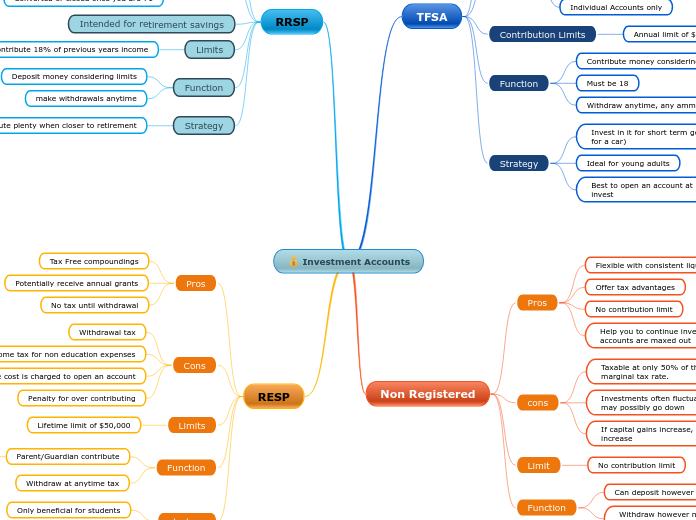Investment Accounts
TFSA
Pros
Investment income is tax free
Withdrawal tax is free
Unused room is carried onto future years
Once retired the investments aren't classified as income
Cons
No tax refund
No spousal plan
Penalties for over contributions
Individual Accounts only
Contribution Limits
Annual limit of $6000
Function
Contribute money considering limits
Must be 18
Withdraw anytime, any ammount
Strategy
Invest in it for short term goals (ex. saving for a car)
Ideal for young adults
Best to open an account at 18, and begin to invest
Non Registered
Pros
Flexible with consistent liquidity
Offer tax advantages
No contribution limit
Help you to continue investing, if registered accounts are maxed out
cons
Taxable at only 50% of the account holder’s marginal tax rate.
Investments often fluctuate, meaning they may possibly go down
If capital gains increase, then taxes will also increase
Limit
No contribution limit
Function
Can deposit however muchyou want
Withdraw however much you want from contributions
RRSP
Pros
Tax-Relief by deducting contributions
Tax Sheltered (I.e. Investments grow tax free)
Cons
Pay tax upon withdrawal
Converted or closed once you are 71
Intended for retirement savings
Limits
Contribute 18% of previous years income
Or
Maximum contribution of $27,230
Function
Deposit money considering limits
make withdrawals anytime
Strategy
Contribute plenty when closer to retirement
RESP
Pros
Tax Free compoundings
Potentially receive annual grants
No tax until withdrawal
Cons
Withdrawal tax
Income tax for non education expenses
Service cost is charged to open an account
Penalty for over contributing
Limits
Lifetime limit of $50,000
Function
Parent/Guardian contribute
Government grants an additional 20% of contribution
Withdraw at anytime tax
strategy
Only beneficial for students
Maximize tax free compounding growth
